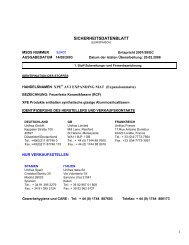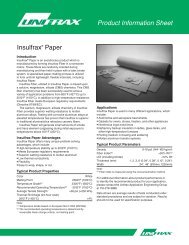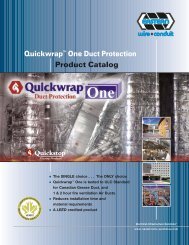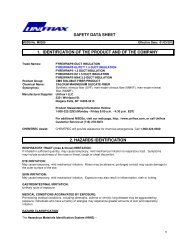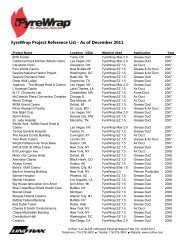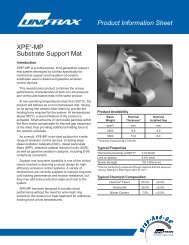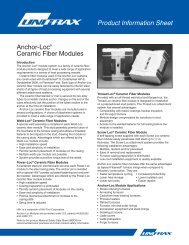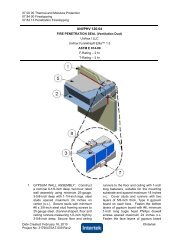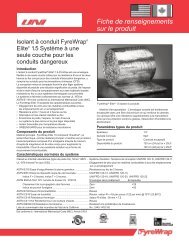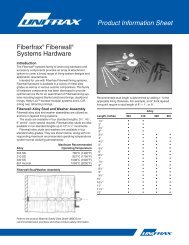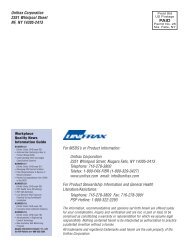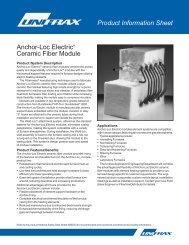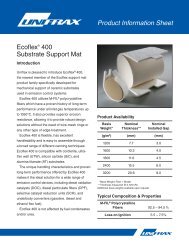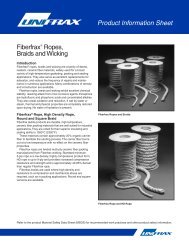XPE® - NV Substrate Support Mat - Unifrax
XPE® - NV Substrate Support Mat - Unifrax
XPE® - NV Substrate Support Mat - Unifrax
You also want an ePaper? Increase the reach of your titles
YUMPU automatically turns print PDFs into web optimized ePapers that Google loves.
Product Information Sheet<br />
XPE ® -<strong>NV</strong><br />
<strong>Substrate</strong> <strong>Support</strong> <strong>Mat</strong><br />
Fiber Technology<br />
<strong>Unifrax</strong> has been offering catalytic converter support<br />
mats used for internal combustion engines since 1980.<br />
Our XPE ® intumescent mat products are designed to<br />
function as mechanical support for the ceramic substrate<br />
and act as an exhaust gas seal while providing thermal<br />
insulation.<br />
<strong>Unifrax</strong> offers a variety of premium and advanced<br />
mat products with enhanced performance properties.<br />
As a manufacturer of fibers used in a variety of catalytic<br />
converter mounting systems, <strong>Unifrax</strong> has successfully<br />
combined fiber making expertise with a state-of-the-art<br />
paper manufacturing process to maximize the<br />
performance of our catalytic converter support mats.<br />
Engineered to meet the performance requirements<br />
associated with traditional catalytic converter applications,<br />
<strong>Unifrax</strong> is pleased to offer XPE ® -<strong>NV</strong> substrate<br />
support mat.<br />
<strong>Unifrax</strong> XPE-<strong>NV</strong> provides a unique balance of<br />
performance versus value and is recommended for a<br />
broad range of catalytic converter substrate support<br />
and cone insulation applications. XPE-<strong>NV</strong> can be<br />
engineered to provide excellent thermal stability at<br />
inlet gas temperatures up to 950°C. The support mat<br />
will expand with increasing relative thickness when<br />
first exposed to temperatures in excess of 325°C.<br />
Expansion pressure is provided by vermiculite particles<br />
trapped in a structural support matrix of Fiberfrax ®<br />
ceramic fibers. The ceramic fibers also provide<br />
resistance to hot gas mat erosion.<br />
Product Availability<br />
Basis Nominal Nominal<br />
Weight Thickness* Installed Gap<br />
(g/m 2 ) mm mm<br />
3100 4.9 3.0<br />
4070 6.5 4.0<br />
6200 11.6 6.0<br />
*Thickness measured @ 0.725 kPa.<br />
Typical Properties<br />
Thermal Conductivity at 650°C*<br />
Loss on Ignition<br />
Tensile Strength<br />
*ASTM-C177<br />
0.18 W/mK<br />
6.0% (min)<br />
100.0 kPa (min)<br />
Chemical Composition<br />
Fiberfrax ® Fibers 35.0% ±5.0%<br />
Vermiculite 55.0% ±5.0%<br />
Binder System 7.0% ±2.0%
Canning Performance<br />
XPE-<strong>NV</strong> is typically installed at a nominal gap bulk density (GBD) of 1.0 g/cm 3 . The room temperature compression behavior<br />
of XPE-<strong>NV</strong> is shown in Figure 1. The GBD range for each specific application will be defined according to the requirements for<br />
holding force and substrate strength. <strong>Unifrax</strong> provides a global network of application engineering services and will provide you<br />
with a support mat recommendation for your specific converter design.<br />
Figure 1:Typical cold compression curve for XPE-<strong>NV</strong> support mat.<br />
Erosion Resistance<br />
<strong>Support</strong> mat erosion may occur as a result of improper support mat installation or due to lack of holding force of the fiber matrix.<br />
Different types of support mat are more susceptible to erosion than others. XPE-<strong>NV</strong> can be properly designed in order to present<br />
a low erosion profile. Additionally, Rigidizer-W can be applied to the exposed edges of XPE-<strong>NV</strong>, thus making it impervious to gas<br />
impingement. Figure 2 presents comparative erosion loss for XPE-<strong>NV</strong> and edge-treated XPE-<strong>NV</strong> as a function of GBD.<br />
Figure 2: Comparative erosion data for XPE-<strong>NV</strong>.<br />
Form C-3087-1<br />
Effective 11/07<br />
© 2007, <strong>Unifrax</strong> I LLC<br />
All Rights Reserved<br />
Printed in USA<br />
Page 2 of 4
<strong>Support</strong> <strong>Mat</strong> Aging Performance – Typical Curve For XPE-<strong>NV</strong><br />
XPE-<strong>NV</strong> is designed to present robust performance at operating temperatures above 600°C. Figure 3 presents a typical aged<br />
mat performance curve for XPE-<strong>NV</strong> as a function of temperature. Factors such as design nominal gap and thermal shell<br />
expansion also influence support mat performance. Please contact our Application Engineering department for additional<br />
information regarding the performance of XPE-<strong>NV</strong> under specific operating conditions.<br />
500<br />
XPE-<strong>NV</strong> <strong>Support</strong> <strong>Mat</strong> System – Nominal Installed GBD<br />
(Typical Aged <strong>Mat</strong> Pressure vs. <strong>Substrate</strong> Skin Temperature – 4.0 mm gap application)<br />
450<br />
400<br />
350<br />
300<br />
250<br />
200<br />
150<br />
100<br />
50<br />
0<br />
300 400 500 600 700 800 900 1000<br />
Figure 3: Typical aged mat pressure for XPE-<strong>NV</strong> as a function of temperature.<br />
Worldwide Technical <strong>Support</strong><br />
<strong>Unifrax</strong> is a worldwide sales and service organization with several international locations and representatives. The services that<br />
we provide include thermal modeling, system design engineering assistance, and failure analysis as well as technical exchange<br />
programs.<br />
For additional information regarding XPE-<strong>NV</strong> or any of our catalytic support mats, please contact the <strong>Unifrax</strong> Automotive<br />
Application Engineering Department at 716-278-3983.<br />
Refer to the product <strong>Mat</strong>erial Safety Data Sheet<br />
(MSDS) for recommended work practices and<br />
other safety information.<br />
Data are average results of tests conducted under<br />
standard procedures and are subject to variation.<br />
Results should not be used for specification purposes.<br />
Form C-3087-1<br />
Effective 11/07<br />
© 2007, <strong>Unifrax</strong> I LLC<br />
All Rights Reserved<br />
Printed in USA<br />
Page 3 of 4
Form C-3087-1<br />
Effective 11/07<br />
© 2007, <strong>Unifrax</strong> I LLC<br />
All Rights Reserved<br />
Printed in USA<br />
Page 4 of 4<br />
The following are registered trademarks of <strong>Unifrax</strong>: XPE and Fiberfrax.<br />
The test data shown are average results of tests conducted under standard procedures and are subject to variation. Results should not be used<br />
for specification purposes.<br />
Product Information Sheets are periodically updated by <strong>Unifrax</strong>. Before relying on any data or other information in this Product Information<br />
Sheet, you should confirm that it is still current and has not been superseded. A Product Information Sheet that has been superseded may<br />
contain incorrect, obsolete and/or irrelevant data and other information.<br />
<strong>Unifrax</strong> I LLC<br />
Corporate Headquarters<br />
2351 Whirlpool Street<br />
Niagara Falls, New York 14305-2413<br />
Telephone: 716-278-3800<br />
Telefax: 716-278-3900<br />
Internet: www.unifrax.com<br />
Email: info@unifrax.com



